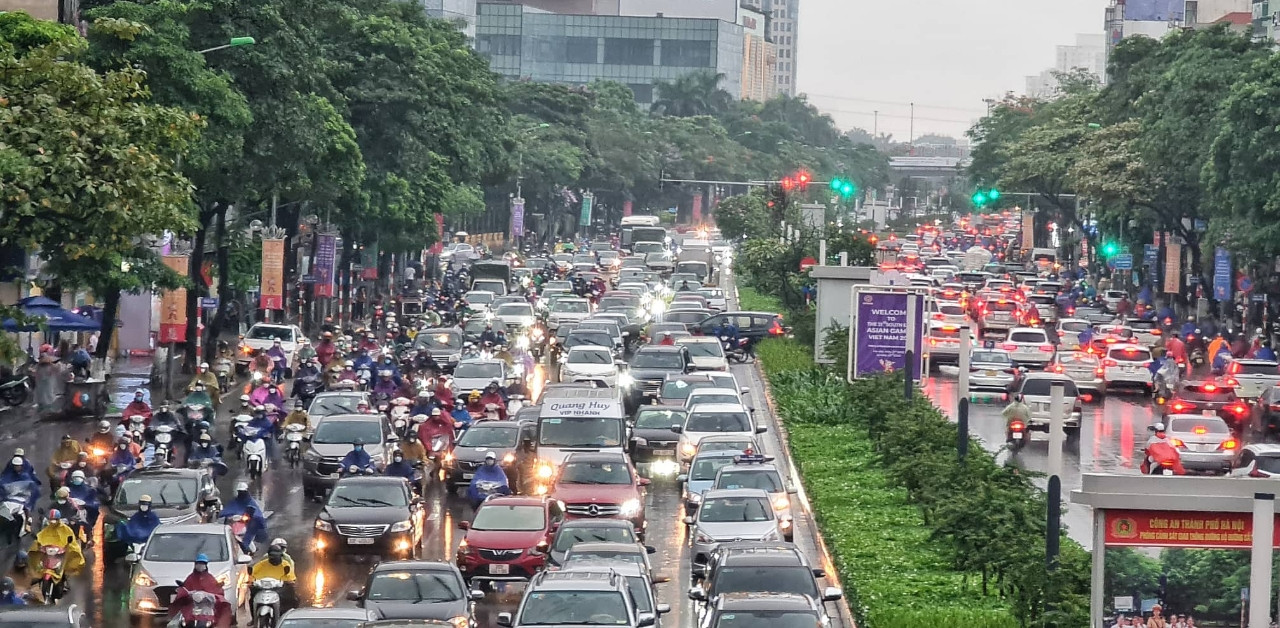Women workers in the textile and garment industry have reduced their working hours by 14% due to the epidemic
Covid-19 caused the total number of working hours of workers in the processing industry to decrease, with female garment workers being the hardest hit, down 14%.
At a seminar on promoting gender equality and economic recovery after the pandemic on the afternoon of May 18, Dr. Khuat Thu Hong, Director of the Institute for Social Development Studies (ISDS), assessed that Covid-19 has caused many negative impacts on the health and safety of people. unprecedented consequences, increasing the unemployment rate among young female workers, causing them to work more than men when reopening.

Female Garment 10 worker (Hanoi) in a shirt production line, March 2022. Image: Hong Chieu
Research in 2021 shows that the pandemic reduces total working hours in the outsourcing and manufacturing industries by 9%, affecting about 5.1 million women working in this sector. Female workers in the textile and garment industry were hardest hit when the total number of working hours decreased by 14% compared to before the epidemic, many were changed jobs, and their contracts were suspended. Meanwhile, in industries with a high concentration of men such as construction, transportation and logistics, public administration, and defense, the total number of hours worked only slightly decreased or even increased.
According to Ms. Hong, women are facing many prejudices and barriers that make it difficult to develop their capacity to contribute more to economic growth and social progress. The average salary of female workers is nearly 30% lower than that of men and in many factories, they are always at risk of sexual harassment.
Although Vietnam has made great strides in narrowing the gender gap, such as the Law on Social Insurance, which adds maternity benefits for men, and takes leave when the wife gives birth. The Labor Code reduces the retirement gap between men and women from 5 years to 2 years by 2035…, but the gender gap persists.
This is reflected in the proportion of female workers of working age participating in social insurance accounts for 60%, higher than that of men, but at retirement age the situation reverses. About 16% of women over 65 have a pension from social insurance, while the proportion of men is 27.3%. By the age of 80, this rate decreased in women to 6.9% and 25.9% in men.
“The majority of female workers in the garment and processing industries leave their villages and return to the land and fields when they reach the end of their working age. But women owning agricultural land is 14% lower than men. It will also be a dilemma in the future,” Dr. Hong suggested.

The off-shift time of leather and footwear worker Pouyuen (Binh Tan district, Ho Chi Minh City). Statistics show that about 75% of workers in the leather, footwear and textile industries are female. Image: Huu Khoa
Ms. Do Hong Van, Acting Head of the Women’s Work Department, Vietnam General Confederation of Labor, said that workers in the textile, garment and footwear industry range in age from 25-40 during the period of childbirth and child rearing. Women at this age have endurance, young strength, which is an advantage but also a challenge, when the level of unskilled and unskilled labor accounts for over 80%, mainly through primary and short-term training of less than 3 months. Promotion opportunities, their income is not equal to that of men.
The textile, garment and footwear industries often work in shift shifts, and the demand for overtime after the epidemic is large, which affects the care of young children and rest of female workers. According to Ms. Van, it is necessary to promote the collective labor agreement; create a safe working environment to minimize sexual harassment of female workers; building trade union institutions in industrial parks associated with houses, kindergartens, medical examination and treatment and entertainment places for workers and their families.
Sharing the same opinion, Ms. Tran Thi Hong Lien, Deputy Director of the VCCI office, emphasized that businesses need to pay more attention to welfare policies, especially for companies with a large number of female employees. She said about 8,000 textile, garment and footwear businesses are employing 4.3 million workers and 75% of them are women. They are bearing the double burden because in addition to work, they also have to take care of the house and take care of their children.
The production recovered after the pandemic, and the increase in overtime made many long-term jobs need female workers. According to Ms. Lien, in the immediate future, it is necessary to quickly disburse the state’s welfare packages such as support for accommodation, reduce procedures and processes so that workers can receive money soon. Enterprises need more health and spiritual care packages for employees after Covid-19; comply with the provisions of the law on labor, especially female employees taking sick leave, maternity leave, taking care of small children… so that they can work with peace of mind. Legal policy in the coming time should have more financial support mechanisms for workers so that they can overcome shocks like the pandemic.
Experts recommend that in the long run, Vietnam needs to improve access to social insurance regimes and benefits for female workers. The revised Law should supplement the maternity leave regime for men when their wives give birth; recruitment, fair pay and more work-life balance policies for female employees.
According to statistics in 2021, Vietnam is falling in the global ranking on the gender gap index. In which, the women’s health and survival index (measured by maternal mortality rate, sex ratio at birth) is the most worrying, as Vietnam has fallen from 138th position in 2016 to second. 152 in 2021. The main reason is that Vietnamese people still prefer boys. Many couples choose the sex of the baby, causing about 46,000 girls each year not to be born.
Hong Chieu
at Blogtuan.info – Source: vnexpress.net – Read the original article here



